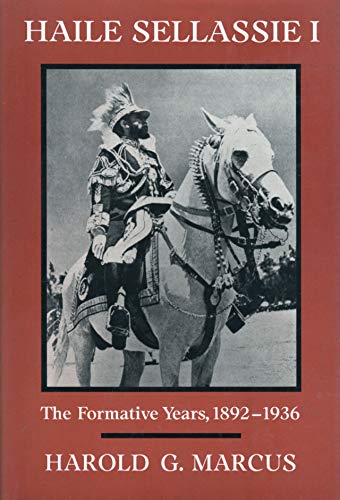Items related to Haile Sellassie I: The Formative Years 1892-1936 (Vol....

"synopsis" may belong to another edition of this title.
The Quai d'Orsay's representative in Addis Ababa invariably advised his host government about how best to strengthen the state or the economy to rebut antagonistic propaganda from London or Rome. To demonstrate the rectitude of keeping Ethiopia weak, officials in those two capitals pointed to various sins of backwardness, in particular, the continued existence of domestic slavery and a flourishing slave trade; an apparently ineffective central government, whose writ appeared to run as far as Addis Ababa's city limits; and an incorporated into the conventional wisdom about Ethiopia, and cited as reasons to keep the Addis Ababa government weak.
Ras Tafari early understood that his country had a serious image problem in Europe. The Ethiopian way of government appeared corrupt and was, in fact, slow to create a consensus; westerners mistook the indirection for misdirection and the languid administrative machinery for inefficiency. Tafari knew that the government needed reform, inevitably a slow process since he did not have enough of a new breed of officials, later dubbed the "Young Ethiopians", who were educated, efficient, modern, and patriotic. Such men might have been relied on to assist in eradicating slavery, regarded by Europeans, if not by most Ethiopians, as anathema, worse indeed than the chaotic internal arms trade. Because solutions to both problems would take years, Tafari chose to temporize with a public relations gambit: on 11 November 1918, he decreed the abolition of the slave trade and the regulation of weapons sales, both necessary if Addis Ababa were to escape the arms embargo revealed Tafari as a serious man with inchoate modern goals.
From the beginning of his career, Tafari's thinking was shaped by a received a memorandum on modernization prepared by two longtime foreign residents. It is an interesting document, not only because it pointed out obviously necessary reforms, but also because it pointed out obviously necessary reforms, but also because Tafari began most of them before the second Italo-Ethiopian war. The two Europeans drew immediate attention to the contemptible condition of the Ethiopian Foreign Ministry, "a little hovel composed entirely of one small room, furnished with a table, and a few chairs and a cupboard." They called for quarters that were appropriate to an organization representing Ethiopia to foreigners and that could demonstrate that the country was "capable and worthy of being independent." That goal would also be served by the installation of legations abroad, to endow Ethiopia with the same quality of sovereignty that other nations enjoyed in foreign capitals. The memorandum also recommended the formation of special courts for municipalities in Addis Ababa, Harer, and Dire Dawa; the introduction of a uniform national currency; the standardization of weapons in the army; the domestic production of munitions; the establishment of model farms; the development of education. The recommended programs required considerable capital, which could only be forced from Ethiopia's domestic economy.
Addis Ababa had "energetically rejected" any scheme that required foreign experts to reorganize and administer the country's finances and rarely had taken foreign loans. The Ethiopians feared falling into arrears and being forced to give up a part of their national sovereignty, as they knew had happened in Egypt, Tunisia, and Morocco. When Tafari became head of the government in 1917, Ethiopia's revenues came largely from customs duties and from tributes, which were slowly evolving into taxes. At the local level, there was a kind of feudalism, whereby producers owed customary taxes and services to a political elite, which administered and policed the Ethiopian Empire. It would be impossible to estimate the value of these transfer payments, but it must have been considerable, permitting southern governors in particular to pay relatively heavy tributes to Addis Ababa in gold, Maria Theresa dollars (MT$), salt bars, ivory, hides and skins, and the like. For 1902, tribute revenues amounted to MT$868, 942; for 1903, MT$1,274,344; and for 1904, MT$2,255,711. The total probably continued to rise throughout Menilek's active years, but it declined after he became ill in 1909, because provincial officials failed to remit all the revenues due the government and, of course, the extra gifts and honorariums customarily sent to the crown.
"About this title" may belong to another edition of this title.
- PublisherUniversity of California Press
- Publication date1987
- ISBN 10 0520056019
- ISBN 13 9780520056015
- BindingHardcover
- Edition number1
- Number of pages242
- Rating
Buy New
Learn more about this copy
Shipping:
US$ 4.00
Within U.S.A.
Top Search Results from the AbeBooks Marketplace
Haile Sellassie I: The Formative Years 1892-1936 (Vol. 1)
Book Description Hardcover. Condition: new. New. Fast Shipping and good customer service. Seller Inventory # Holz_New_0520056019
Haile Sellassie I: The Formative Years 1892-1936 (Vol. 1)
Book Description Hardcover. Condition: new. Prompt service guaranteed. Seller Inventory # Clean0520056019
Haile Sellassie I: The Formative Years 1892-1936 (Vol. 1)
Book Description Condition: new. Seller Inventory # FrontCover0520056019
Haile Sellassie I: The Formative Years 1892-1936 (Vol. 1)
Book Description Hardcover. Condition: new. New. Seller Inventory # Wizard0520056019
Haile Sellassie I: The Formative Years 1892-1936 (Vol. 1)
Book Description Hardcover. Condition: new. New Copy. Customer Service Guaranteed. Seller Inventory # think0520056019
HAILE SELLASSIE I: THE FORMATIVE
Book Description Condition: New. New. In shrink wrap. Looks like an interesting title! 1.36. Seller Inventory # Q-0520056019
Haile Sellassie I: The Formative Years 1892-1936 (Vol. 1)
Book Description Condition: New. Book is in NEW condition. Seller Inventory # 0520056019-2-1

